Business Process Modelling: Research Paper Review and Analysis, Report
VerifiedAdded on 2023/01/04
|7
|1902
|82
Report
AI Summary
This report provides a comprehensive review and analysis of a research paper titled "Real-time business activity monitoring and analysis of process performance on big-data domains." The study, authored by Molloy et al., investigates the necessity of real-time monitoring of business processes to identify errors and inefficiencies, especially in areas like supply chains. The paper highlights the limitations of current Business Activity Monitoring (BAM) and Business Intelligence (BI) technologies and proposes a cloud-based solution leveraging big data and cloud computing to address challenges such as the need for re-engineered BI platforms and event correlation across organizational boundaries. The proposed solution utilizes a Global Business Analytics Service (GBAS) and Business Analytics Service Units (BASU) to analyze and monitor operational activities. It also introduces an event-based model and repository for metrics generation and analysis. The evaluation of the solution is done using a case study in the smart cities area, demonstrating its practical application in analyzing and monitoring smart services. The report concludes by emphasizing the importance of cloud-based infrastructure and the potential for future research in areas like collaborative business analytics and process mining.
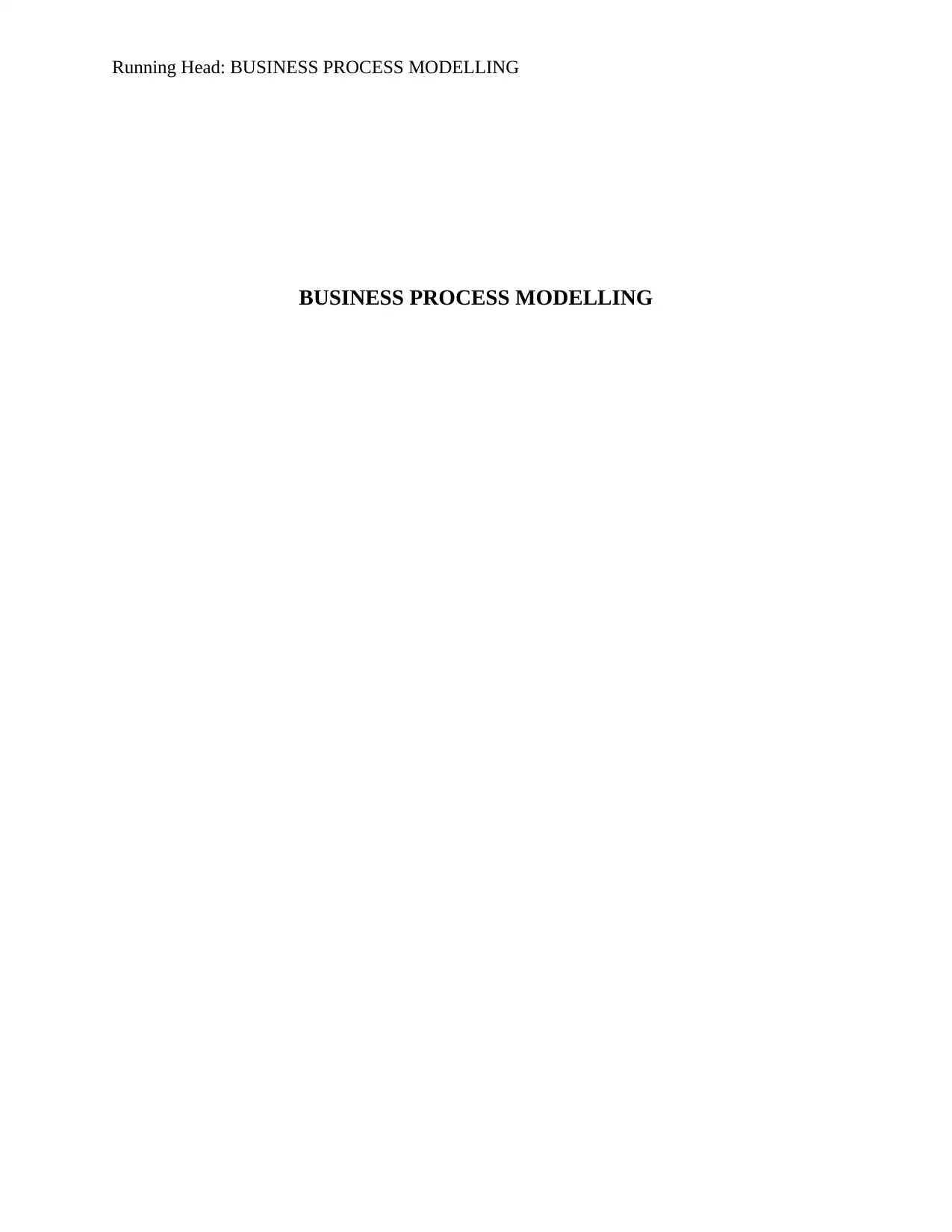
Running Head: BUSINESS PROCESS MODELLING
BUSINESS PROCESS MODELLING
BUSINESS PROCESS MODELLING
Paraphrase This Document
Need a fresh take? Get an instant paraphrase of this document with our AI Paraphraser
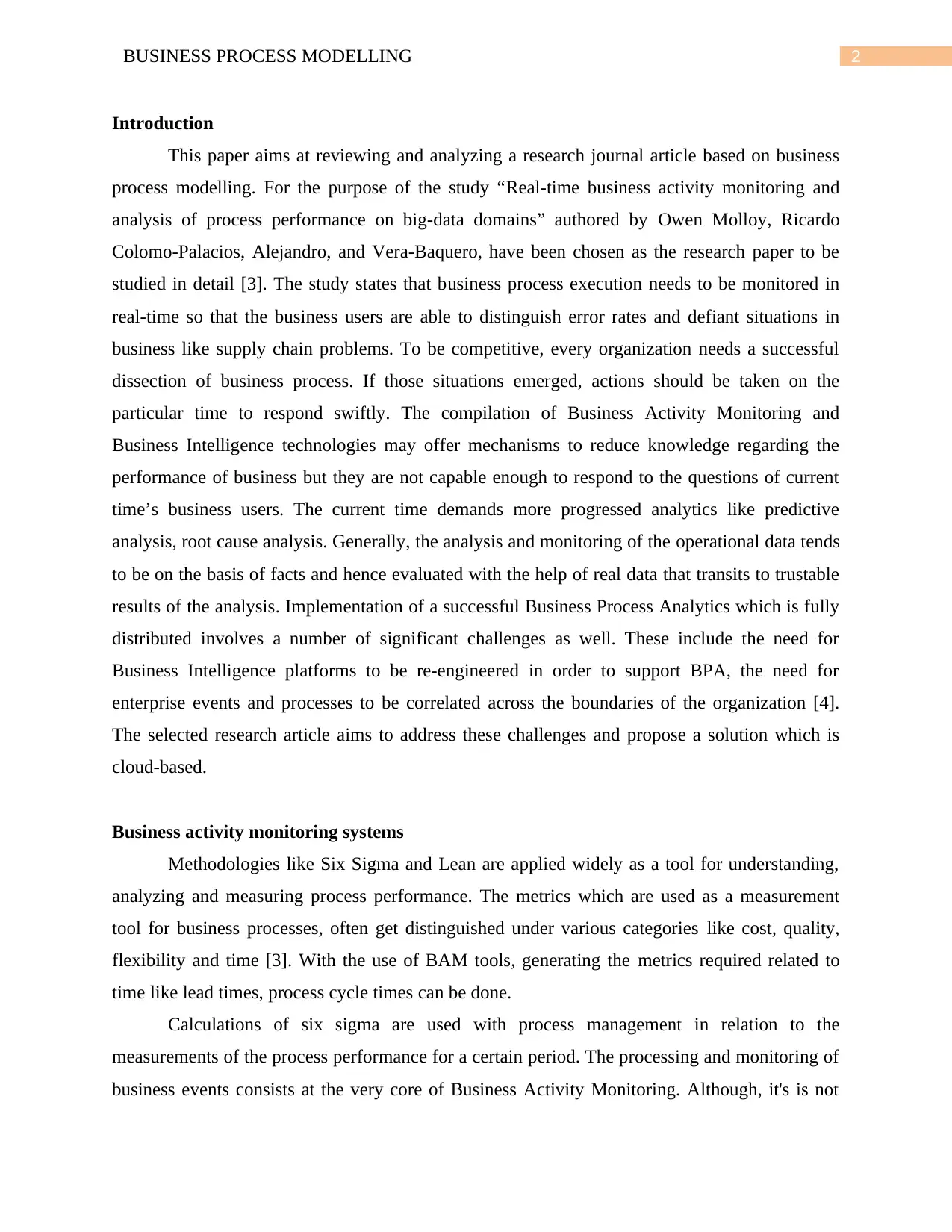
2BUSINESS PROCESS MODELLING
Introduction
This paper aims at reviewing and analyzing a research journal article based on business
process modelling. For the purpose of the study “Real-time business activity monitoring and
analysis of process performance on big-data domains” authored by Owen Molloy, Ricardo
Colomo-Palacios, Alejandro, and Vera-Baquero, have been chosen as the research paper to be
studied in detail [3]. The study states that business process execution needs to be monitored in
real-time so that the business users are able to distinguish error rates and defiant situations in
business like supply chain problems. To be competitive, every organization needs a successful
dissection of business process. If those situations emerged, actions should be taken on the
particular time to respond swiftly. The compilation of Business Activity Monitoring and
Business Intelligence technologies may offer mechanisms to reduce knowledge regarding the
performance of business but they are not capable enough to respond to the questions of current
time’s business users. The current time demands more progressed analytics like predictive
analysis, root cause analysis. Generally, the analysis and monitoring of the operational data tends
to be on the basis of facts and hence evaluated with the help of real data that transits to trustable
results of the analysis. Implementation of a successful Business Process Analytics which is fully
distributed involves a number of significant challenges as well. These include the need for
Business Intelligence platforms to be re-engineered in order to support BPA, the need for
enterprise events and processes to be correlated across the boundaries of the organization [4].
The selected research article aims to address these challenges and propose a solution which is
cloud-based.
Business activity monitoring systems
Methodologies like Six Sigma and Lean are applied widely as a tool for understanding,
analyzing and measuring process performance. The metrics which are used as a measurement
tool for business processes, often get distinguished under various categories like cost, quality,
flexibility and time [3]. With the use of BAM tools, generating the metrics required related to
time like lead times, process cycle times can be done.
Calculations of six sigma are used with process management in relation to the
measurements of the process performance for a certain period. The processing and monitoring of
business events consists at the very core of Business Activity Monitoring. Although, it's is not
Introduction
This paper aims at reviewing and analyzing a research journal article based on business
process modelling. For the purpose of the study “Real-time business activity monitoring and
analysis of process performance on big-data domains” authored by Owen Molloy, Ricardo
Colomo-Palacios, Alejandro, and Vera-Baquero, have been chosen as the research paper to be
studied in detail [3]. The study states that business process execution needs to be monitored in
real-time so that the business users are able to distinguish error rates and defiant situations in
business like supply chain problems. To be competitive, every organization needs a successful
dissection of business process. If those situations emerged, actions should be taken on the
particular time to respond swiftly. The compilation of Business Activity Monitoring and
Business Intelligence technologies may offer mechanisms to reduce knowledge regarding the
performance of business but they are not capable enough to respond to the questions of current
time’s business users. The current time demands more progressed analytics like predictive
analysis, root cause analysis. Generally, the analysis and monitoring of the operational data tends
to be on the basis of facts and hence evaluated with the help of real data that transits to trustable
results of the analysis. Implementation of a successful Business Process Analytics which is fully
distributed involves a number of significant challenges as well. These include the need for
Business Intelligence platforms to be re-engineered in order to support BPA, the need for
enterprise events and processes to be correlated across the boundaries of the organization [4].
The selected research article aims to address these challenges and propose a solution which is
cloud-based.
Business activity monitoring systems
Methodologies like Six Sigma and Lean are applied widely as a tool for understanding,
analyzing and measuring process performance. The metrics which are used as a measurement
tool for business processes, often get distinguished under various categories like cost, quality,
flexibility and time [3]. With the use of BAM tools, generating the metrics required related to
time like lead times, process cycle times can be done.
Calculations of six sigma are used with process management in relation to the
measurements of the process performance for a certain period. The processing and monitoring of
business events consists at the very core of Business Activity Monitoring. Although, it's is not
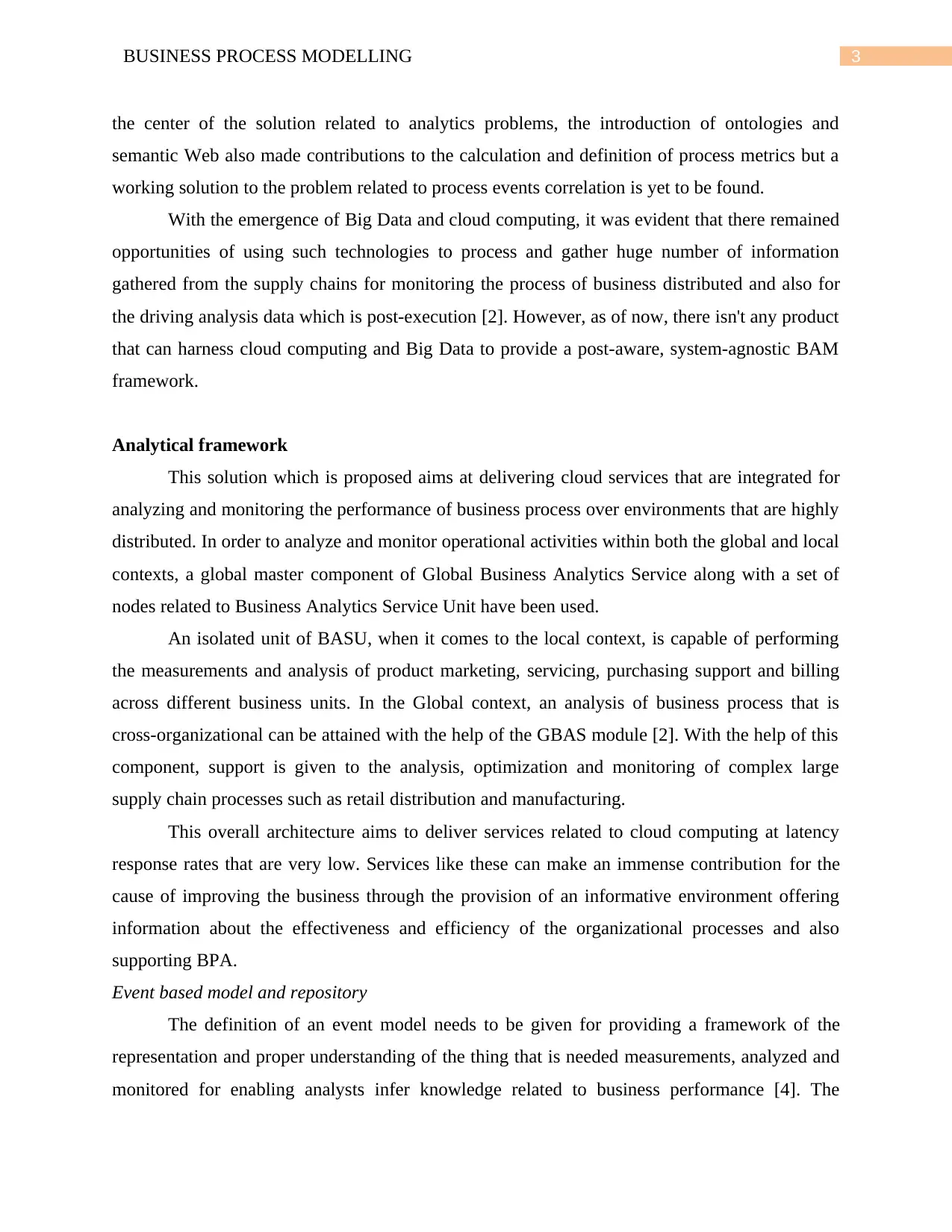
3BUSINESS PROCESS MODELLING
the center of the solution related to analytics problems, the introduction of ontologies and
semantic Web also made contributions to the calculation and definition of process metrics but a
working solution to the problem related to process events correlation is yet to be found.
With the emergence of Big Data and cloud computing, it was evident that there remained
opportunities of using such technologies to process and gather huge number of information
gathered from the supply chains for monitoring the process of business distributed and also for
the driving analysis data which is post-execution [2]. However, as of now, there isn't any product
that can harness cloud computing and Big Data to provide a post-aware, system-agnostic BAM
framework.
Analytical framework
This solution which is proposed aims at delivering cloud services that are integrated for
analyzing and monitoring the performance of business process over environments that are highly
distributed. In order to analyze and monitor operational activities within both the global and local
contexts, a global master component of Global Business Analytics Service along with a set of
nodes related to Business Analytics Service Unit have been used.
An isolated unit of BASU, when it comes to the local context, is capable of performing
the measurements and analysis of product marketing, servicing, purchasing support and billing
across different business units. In the Global context, an analysis of business process that is
cross-organizational can be attained with the help of the GBAS module [2]. With the help of this
component, support is given to the analysis, optimization and monitoring of complex large
supply chain processes such as retail distribution and manufacturing.
This overall architecture aims to deliver services related to cloud computing at latency
response rates that are very low. Services like these can make an immense contribution for the
cause of improving the business through the provision of an informative environment offering
information about the effectiveness and efficiency of the organizational processes and also
supporting BPA.
Event based model and repository
The definition of an event model needs to be given for providing a framework of the
representation and proper understanding of the thing that is needed measurements, analyzed and
monitored for enabling analysts infer knowledge related to business performance [4]. The
the center of the solution related to analytics problems, the introduction of ontologies and
semantic Web also made contributions to the calculation and definition of process metrics but a
working solution to the problem related to process events correlation is yet to be found.
With the emergence of Big Data and cloud computing, it was evident that there remained
opportunities of using such technologies to process and gather huge number of information
gathered from the supply chains for monitoring the process of business distributed and also for
the driving analysis data which is post-execution [2]. However, as of now, there isn't any product
that can harness cloud computing and Big Data to provide a post-aware, system-agnostic BAM
framework.
Analytical framework
This solution which is proposed aims at delivering cloud services that are integrated for
analyzing and monitoring the performance of business process over environments that are highly
distributed. In order to analyze and monitor operational activities within both the global and local
contexts, a global master component of Global Business Analytics Service along with a set of
nodes related to Business Analytics Service Unit have been used.
An isolated unit of BASU, when it comes to the local context, is capable of performing
the measurements and analysis of product marketing, servicing, purchasing support and billing
across different business units. In the Global context, an analysis of business process that is
cross-organizational can be attained with the help of the GBAS module [2]. With the help of this
component, support is given to the analysis, optimization and monitoring of complex large
supply chain processes such as retail distribution and manufacturing.
This overall architecture aims to deliver services related to cloud computing at latency
response rates that are very low. Services like these can make an immense contribution for the
cause of improving the business through the provision of an informative environment offering
information about the effectiveness and efficiency of the organizational processes and also
supporting BPA.
Event based model and repository
The definition of an event model needs to be given for providing a framework of the
representation and proper understanding of the thing that is needed measurements, analyzed and
monitored for enabling analysts infer knowledge related to business performance [4]. The
⊘ This is a preview!⊘
Do you want full access?
Subscribe today to unlock all pages.

Trusted by 1+ million students worldwide
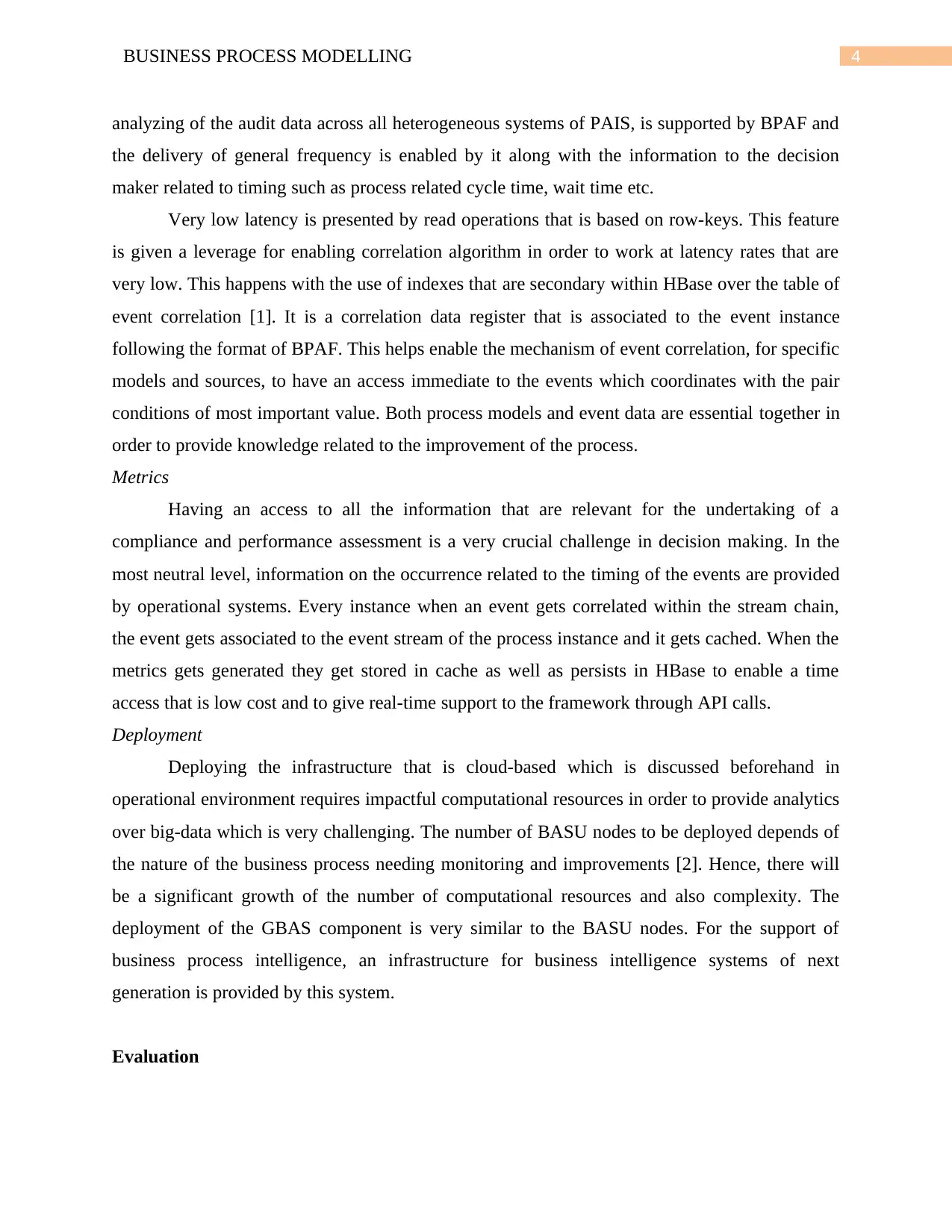
4BUSINESS PROCESS MODELLING
analyzing of the audit data across all heterogeneous systems of PAIS, is supported by BPAF and
the delivery of general frequency is enabled by it along with the information to the decision
maker related to timing such as process related cycle time, wait time etc.
Very low latency is presented by read operations that is based on row-keys. This feature
is given a leverage for enabling correlation algorithm in order to work at latency rates that are
very low. This happens with the use of indexes that are secondary within HBase over the table of
event correlation [1]. It is a correlation data register that is associated to the event instance
following the format of BPAF. This helps enable the mechanism of event correlation, for specific
models and sources, to have an access immediate to the events which coordinates with the pair
conditions of most important value. Both process models and event data are essential together in
order to provide knowledge related to the improvement of the process.
Metrics
Having an access to all the information that are relevant for the undertaking of a
compliance and performance assessment is a very crucial challenge in decision making. In the
most neutral level, information on the occurrence related to the timing of the events are provided
by operational systems. Every instance when an event gets correlated within the stream chain,
the event gets associated to the event stream of the process instance and it gets cached. When the
metrics gets generated they get stored in cache as well as persists in HBase to enable a time
access that is low cost and to give real-time support to the framework through API calls.
Deployment
Deploying the infrastructure that is cloud-based which is discussed beforehand in
operational environment requires impactful computational resources in order to provide analytics
over big-data which is very challenging. The number of BASU nodes to be deployed depends of
the nature of the business process needing monitoring and improvements [2]. Hence, there will
be a significant growth of the number of computational resources and also complexity. The
deployment of the GBAS component is very similar to the BASU nodes. For the support of
business process intelligence, an infrastructure for business intelligence systems of next
generation is provided by this system.
Evaluation
analyzing of the audit data across all heterogeneous systems of PAIS, is supported by BPAF and
the delivery of general frequency is enabled by it along with the information to the decision
maker related to timing such as process related cycle time, wait time etc.
Very low latency is presented by read operations that is based on row-keys. This feature
is given a leverage for enabling correlation algorithm in order to work at latency rates that are
very low. This happens with the use of indexes that are secondary within HBase over the table of
event correlation [1]. It is a correlation data register that is associated to the event instance
following the format of BPAF. This helps enable the mechanism of event correlation, for specific
models and sources, to have an access immediate to the events which coordinates with the pair
conditions of most important value. Both process models and event data are essential together in
order to provide knowledge related to the improvement of the process.
Metrics
Having an access to all the information that are relevant for the undertaking of a
compliance and performance assessment is a very crucial challenge in decision making. In the
most neutral level, information on the occurrence related to the timing of the events are provided
by operational systems. Every instance when an event gets correlated within the stream chain,
the event gets associated to the event stream of the process instance and it gets cached. When the
metrics gets generated they get stored in cache as well as persists in HBase to enable a time
access that is low cost and to give real-time support to the framework through API calls.
Deployment
Deploying the infrastructure that is cloud-based which is discussed beforehand in
operational environment requires impactful computational resources in order to provide analytics
over big-data which is very challenging. The number of BASU nodes to be deployed depends of
the nature of the business process needing monitoring and improvements [2]. Hence, there will
be a significant growth of the number of computational resources and also complexity. The
deployment of the GBAS component is very similar to the BASU nodes. For the support of
business process intelligence, an infrastructure for business intelligence systems of next
generation is provided by this system.
Evaluation
Paraphrase This Document
Need a fresh take? Get an instant paraphrase of this document with our AI Paraphraser
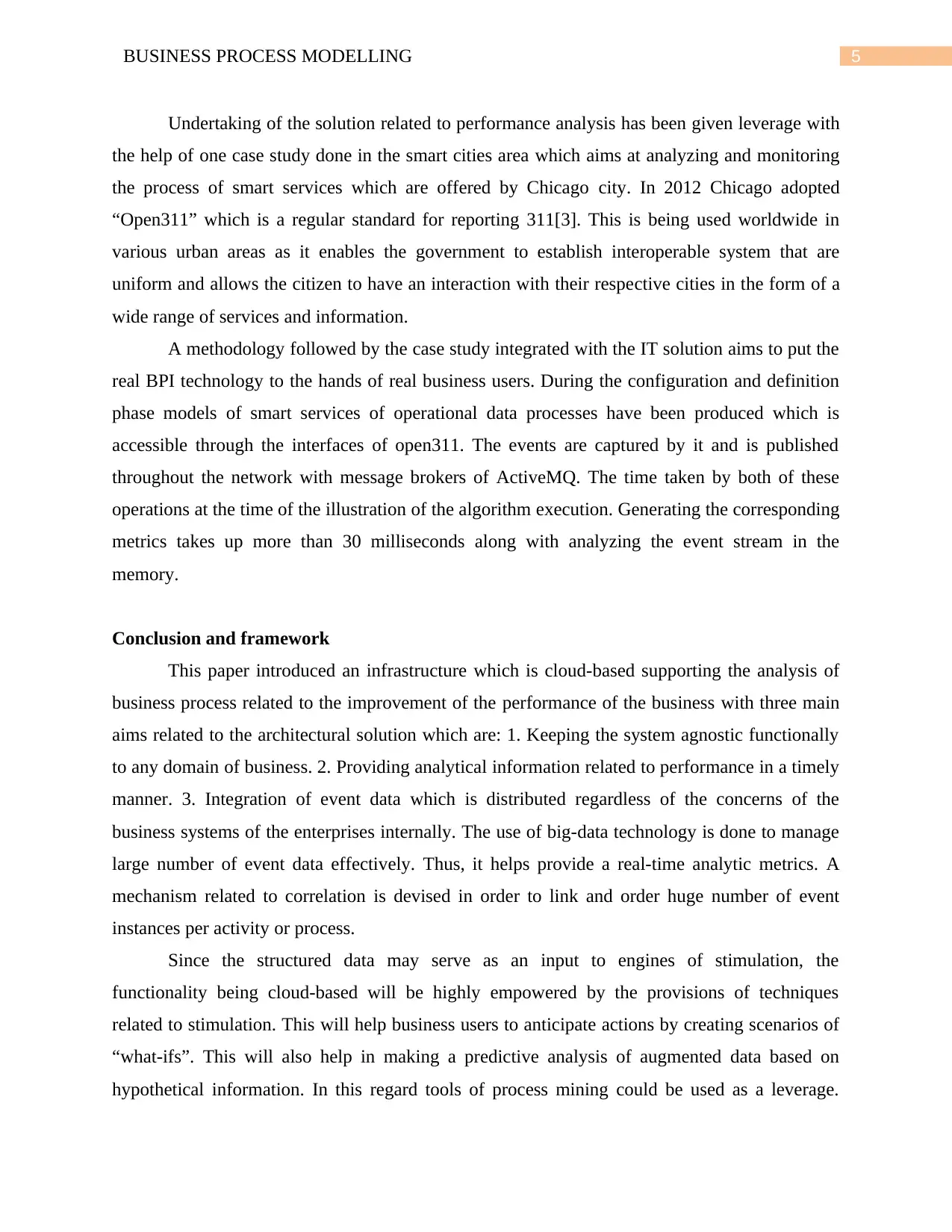
5BUSINESS PROCESS MODELLING
Undertaking of the solution related to performance analysis has been given leverage with
the help of one case study done in the smart cities area which aims at analyzing and monitoring
the process of smart services which are offered by Chicago city. In 2012 Chicago adopted
“Open311” which is a regular standard for reporting 311[3]. This is being used worldwide in
various urban areas as it enables the government to establish interoperable system that are
uniform and allows the citizen to have an interaction with their respective cities in the form of a
wide range of services and information.
A methodology followed by the case study integrated with the IT solution aims to put the
real BPI technology to the hands of real business users. During the configuration and definition
phase models of smart services of operational data processes have been produced which is
accessible through the interfaces of open311. The events are captured by it and is published
throughout the network with message brokers of ActiveMQ. The time taken by both of these
operations at the time of the illustration of the algorithm execution. Generating the corresponding
metrics takes up more than 30 milliseconds along with analyzing the event stream in the
memory.
Conclusion and framework
This paper introduced an infrastructure which is cloud-based supporting the analysis of
business process related to the improvement of the performance of the business with three main
aims related to the architectural solution which are: 1. Keeping the system agnostic functionally
to any domain of business. 2. Providing analytical information related to performance in a timely
manner. 3. Integration of event data which is distributed regardless of the concerns of the
business systems of the enterprises internally. The use of big-data technology is done to manage
large number of event data effectively. Thus, it helps provide a real-time analytic metrics. A
mechanism related to correlation is devised in order to link and order huge number of event
instances per activity or process.
Since the structured data may serve as an input to engines of stimulation, the
functionality being cloud-based will be highly empowered by the provisions of techniques
related to stimulation. This will help business users to anticipate actions by creating scenarios of
“what-ifs”. This will also help in making a predictive analysis of augmented data based on
hypothetical information. In this regard tools of process mining could be used as a leverage.
Undertaking of the solution related to performance analysis has been given leverage with
the help of one case study done in the smart cities area which aims at analyzing and monitoring
the process of smart services which are offered by Chicago city. In 2012 Chicago adopted
“Open311” which is a regular standard for reporting 311[3]. This is being used worldwide in
various urban areas as it enables the government to establish interoperable system that are
uniform and allows the citizen to have an interaction with their respective cities in the form of a
wide range of services and information.
A methodology followed by the case study integrated with the IT solution aims to put the
real BPI technology to the hands of real business users. During the configuration and definition
phase models of smart services of operational data processes have been produced which is
accessible through the interfaces of open311. The events are captured by it and is published
throughout the network with message brokers of ActiveMQ. The time taken by both of these
operations at the time of the illustration of the algorithm execution. Generating the corresponding
metrics takes up more than 30 milliseconds along with analyzing the event stream in the
memory.
Conclusion and framework
This paper introduced an infrastructure which is cloud-based supporting the analysis of
business process related to the improvement of the performance of the business with three main
aims related to the architectural solution which are: 1. Keeping the system agnostic functionally
to any domain of business. 2. Providing analytical information related to performance in a timely
manner. 3. Integration of event data which is distributed regardless of the concerns of the
business systems of the enterprises internally. The use of big-data technology is done to manage
large number of event data effectively. Thus, it helps provide a real-time analytic metrics. A
mechanism related to correlation is devised in order to link and order huge number of event
instances per activity or process.
Since the structured data may serve as an input to engines of stimulation, the
functionality being cloud-based will be highly empowered by the provisions of techniques
related to stimulation. This will help business users to anticipate actions by creating scenarios of
“what-ifs”. This will also help in making a predictive analysis of augmented data based on
hypothetical information. In this regard tools of process mining could be used as a leverage.

6BUSINESS PROCESS MODELLING
Another potential area of research which can be explored is the analytics related to collaborative
business.
Another potential area of research which can be explored is the analytics related to collaborative
business.
⊘ This is a preview!⊘
Do you want full access?
Subscribe today to unlock all pages.

Trusted by 1+ million students worldwide
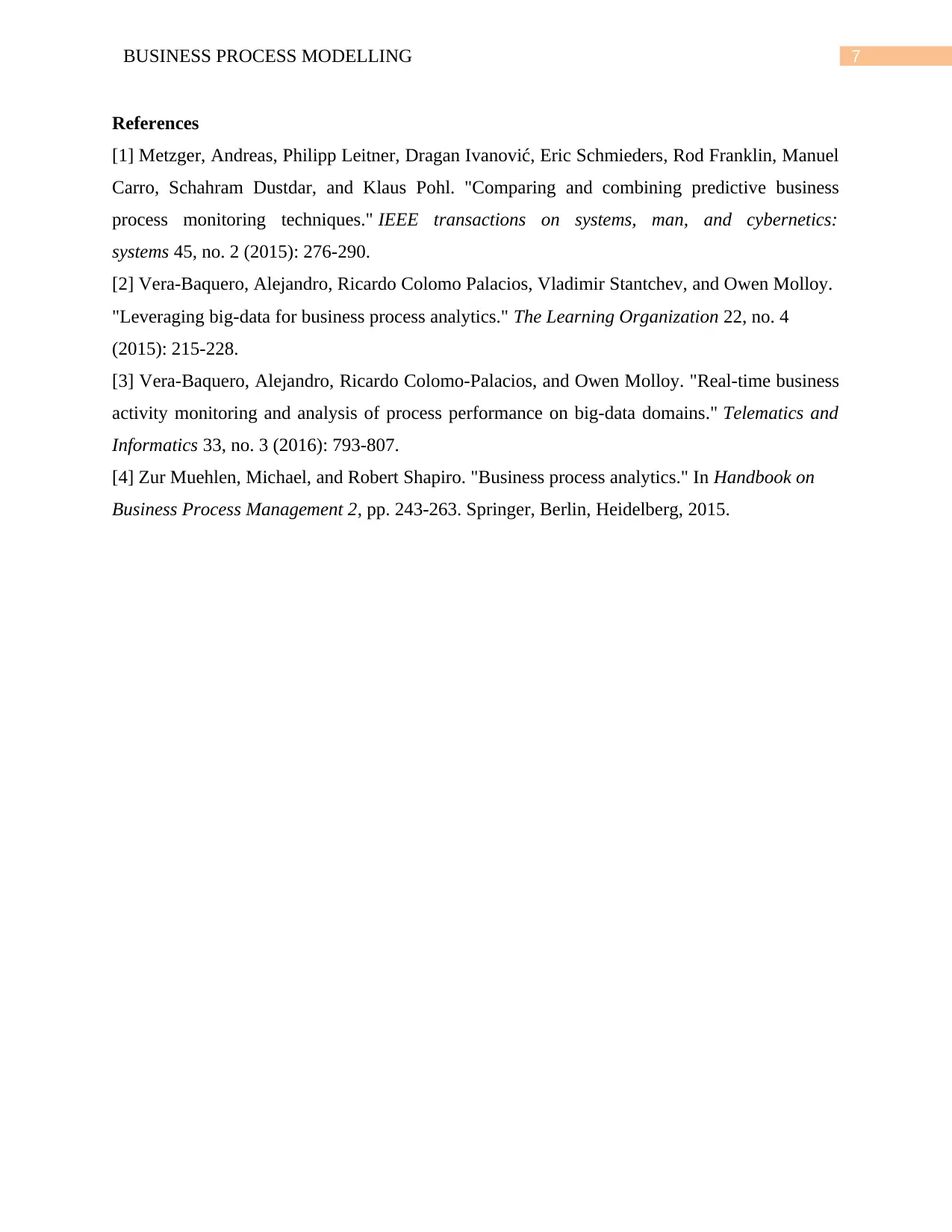
7BUSINESS PROCESS MODELLING
References
[1] Metzger, Andreas, Philipp Leitner, Dragan Ivanović, Eric Schmieders, Rod Franklin, Manuel
Carro, Schahram Dustdar, and Klaus Pohl. "Comparing and combining predictive business
process monitoring techniques." IEEE transactions on systems, man, and cybernetics:
systems 45, no. 2 (2015): 276-290.
[2] Vera-Baquero, Alejandro, Ricardo Colomo Palacios, Vladimir Stantchev, and Owen Molloy.
"Leveraging big-data for business process analytics." The Learning Organization 22, no. 4
(2015): 215-228.
[3] Vera-Baquero, Alejandro, Ricardo Colomo-Palacios, and Owen Molloy. "Real-time business
activity monitoring and analysis of process performance on big-data domains." Telematics and
Informatics 33, no. 3 (2016): 793-807.
[4] Zur Muehlen, Michael, and Robert Shapiro. "Business process analytics." In Handbook on
Business Process Management 2, pp. 243-263. Springer, Berlin, Heidelberg, 2015.
References
[1] Metzger, Andreas, Philipp Leitner, Dragan Ivanović, Eric Schmieders, Rod Franklin, Manuel
Carro, Schahram Dustdar, and Klaus Pohl. "Comparing and combining predictive business
process monitoring techniques." IEEE transactions on systems, man, and cybernetics:
systems 45, no. 2 (2015): 276-290.
[2] Vera-Baquero, Alejandro, Ricardo Colomo Palacios, Vladimir Stantchev, and Owen Molloy.
"Leveraging big-data for business process analytics." The Learning Organization 22, no. 4
(2015): 215-228.
[3] Vera-Baquero, Alejandro, Ricardo Colomo-Palacios, and Owen Molloy. "Real-time business
activity monitoring and analysis of process performance on big-data domains." Telematics and
Informatics 33, no. 3 (2016): 793-807.
[4] Zur Muehlen, Michael, and Robert Shapiro. "Business process analytics." In Handbook on
Business Process Management 2, pp. 243-263. Springer, Berlin, Heidelberg, 2015.
1 out of 7
Related Documents
Your All-in-One AI-Powered Toolkit for Academic Success.
+13062052269
info@desklib.com
Available 24*7 on WhatsApp / Email
![[object Object]](/_next/static/media/star-bottom.7253800d.svg)
Unlock your academic potential
Copyright © 2020–2025 A2Z Services. All Rights Reserved. Developed and managed by ZUCOL.





